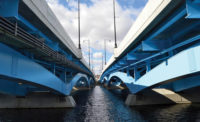Northeastern University ISEC Pedestrian Crossing
Boston
Awards of Merit
Owner: Northeastern University
Owner’s Representative: Hill International Inc.
Lead Design Firm: Payette Associates Inc. (PAI)
General Contractor: Skanska USA Northeast Civil Inc.
Civil Engineer: VHB
MEP/Structural Engineer: Arup USA
Landscape Architect: STIMSON
Subcontractors: Coghlin Electrical; JAJ Tile Co. (Hardscape); Xquisite Landscaping; King Fabrication (Steel Fabrication and Erection); Atlantic Bridge & Engineering (Steel Fabrication and Erection)
Spanning five passenger rail tracks, the 500-ft-long steel box girder bridge connects both halves of the university campus and their surrounding neighborhoods. The bridge curves as it crests over the rail corridor, expanding into an observation platform. Building the bridge within a congested site and across an active rail corridor demanded stringent safety protocols as well as measures to prevent rail service disruption during the 22-month, nearly $25-million job. The project team assembled most of the bridge, parapets and other elements into two spans off site, then placed the structures via crane during a three-hour overnight work window. In addition to decreasing fall risk exposure and limited railroad electrical outage time, preassembly also provided better illumination conditions and better quality control. Day-to-day safety issues were managed via a plan-do-check-act system that included daily reviews of job hazard analyses and monthly general awareness safety training for workers.
To prevent main-span parapets from deflection during the subsequent concrete deck pour, finite element modeling with ballasting during preassembly simulated the final deflection condition. Welds were field-tested using phased array ultrasonic technology, which eliminated the risk of harmful X-rays and allowed the nearby library to remain open. Formed entirely of weathering steel, the structure’s metallurgy is designed to rust in a controlled, deliberate manner to form a protective corrosion-resistant surface layer.





Post a comment to this article
Report Abusive Comment